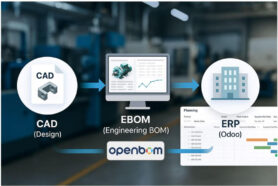
In any product development project, there are a lot of moving parts. You’ve got to keep track of CAD design, bill of materials (BOMs), design files, prototype builds, testing results, and more. Trying to manage all of that information can quickly become overwhelming, especially if you’re still using not organized documents and spreadsheets to keep everything running. That’s where OpenBOM comes in.
OpenBOM is a cloud-based platform that helps you manage all of the data associated with your product development projects and connect suppliers and contractors together from both data and process standpoints. Not only does this make it easier for you to find the information you need when you need it, but it also helps to streamline the overall product development process.
Modern product development and manufacturing are all about speed. Design faster, prototype faster, buy faster, build faster, ship faster… Companies are looking at how to make everything faster to beat the time to market of their competitors and answer customer demands. When I speak to manufacturing companies, everyone is asking me the same questions – how can OpenBOM help us be faster and more efficient? It is fundamentally getting back to the discussion about how to streamline your product development process.
In my article today, I want to talk about three things OpenBOM can do to streamline your product development projects.
Optimize NDP/NPI process
When it comes to new product development, the team should be working together in the most coordinated way. How to make it happen? Stop wasting time on how to store information, how to share it, and how to perform manual tasks. Making new products requires multiple people working on the design in parallel, combining their results together to build prototypes faster. Building prototypes requires ordering the shelf components, ordering work to be done by contractors, and assembling prototypes on time. The process described above needs to be repeated to finally go through multiple prototypes and get to the results of delivering a new product.
OpenBOM design to purchasing process is an end-to-end experience that helps you organize all CAD files, and BOMs, to manage orders, vendors, and RFQ/POs together to get results done. The picture below gives you an idea of how OpenBOM does it. Check for more here.
Connect People From Multiple Organizations
Days when companies were working in a single building and manufacturing companies were building everything from iron and steel to cars are over. Product development today is an orchestrated work of multiple companies. However, legacy systems are not designed to help companies to work together in a coordinated fashion. Even if a company has PLM systems, they are not capable of sharing data between multiple companies in an easy way.
OpenBOM is built from scratch in a multi-tenant way allowing everyone to share data in a granular and instant way. Multiple companies can manage CAD design, create Bills of Materials and immediately combine all their work together in one single top-level BOM delivered by multiple companies with a rollup cost instantly calculated based on real-time data.
Read the story of Tomcar using OpenBOM connect information coming from multiple contractors and suppliers in a single virtual car bill of materials.
“Simply put, before OpenBOM, we did not have a final BOM that was accurate or easy to share”, he says, “We needed a full product BOM which OpenBOM delivered!” For Tomcar, OpenBOM provided the level of communication they had been looking for. “We have detailed formal agreements with partners, we could tell them what to build [in terms of the product], but couldn’t tell me what to buy, there was too much Tribal Knowledge!”, said Jonathan Drori lead engineer at Tomcar.
Reduce Cost by Making Everything “Connected”
One of the biggest advantages of using OpenBOM is that it keeps all of your project information in one central location. This includes BOMs, design files, prototype build information, test results, and more. Having everything in one place and shared makes it much easier to find the information you need when you need it and reduces the likelihood of important information getting lost in the shuffle.
Another big advantage of using OpenBOM is that it makes it easy to generate and update BOMs. With OpenBOM, you can quickly and easily create a BOM for your project, add or remove items from the BOM as needed, and automatically update the BOM based on changes made to the design files. This helps to ensure that everyone involved in the project always has access to the most up-to-date BOM.
OpenBOM also makes it easy to generate cost rollups for your product development projects. With just a few clicks, you can generate rollups, calculations and reports that show the status of a project, what’s been completed, what’s still left to do, and more. This is a great way to keep stakeholders updated on the progress of a project and identify any potential bottlenecks before they become a problem.
Conclusion:
Modern products require modern tools. You cannot build a modern new product using archaic tools and a bunch of spreadsheets. If you’re looking for a way to streamline your product development projects, then OpenBOM will give you great value by providing modern data management and collaboration tools fully integrated with your existing CAD and other design tools. With its centralized data management capabilities, real-time collaboration tools and easy-to-use user experience, OpenBOM has everything you need to keep your product development projects running smoothly from start to finish.
REGISTER FOR FREE and start a 14 day trial to see firsthand how OpenBOM can help you today.
Best, Oleg
Join our newsletter to receive a weekly portion of news, articles, and tips about OpenBOM and our community.










